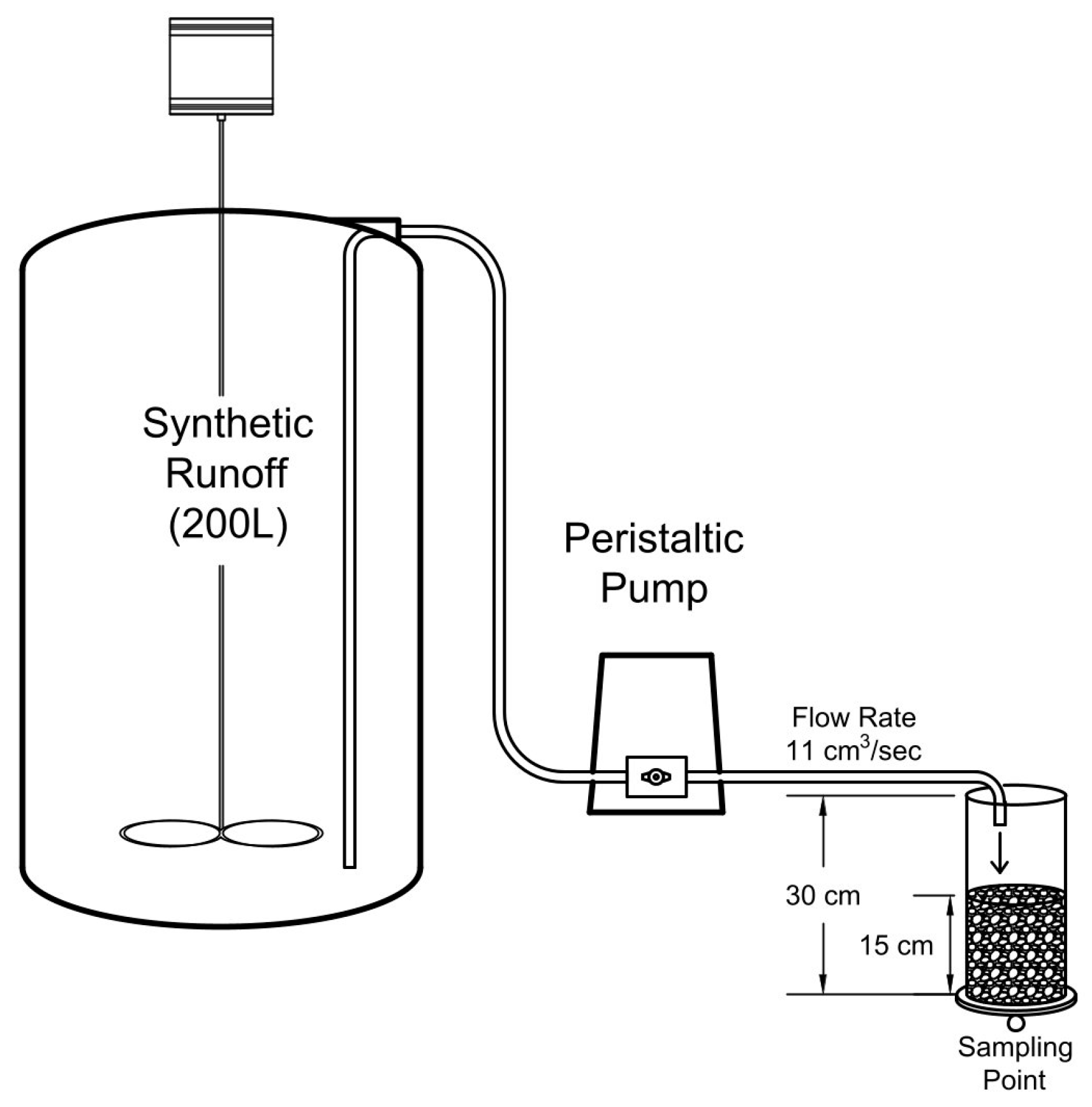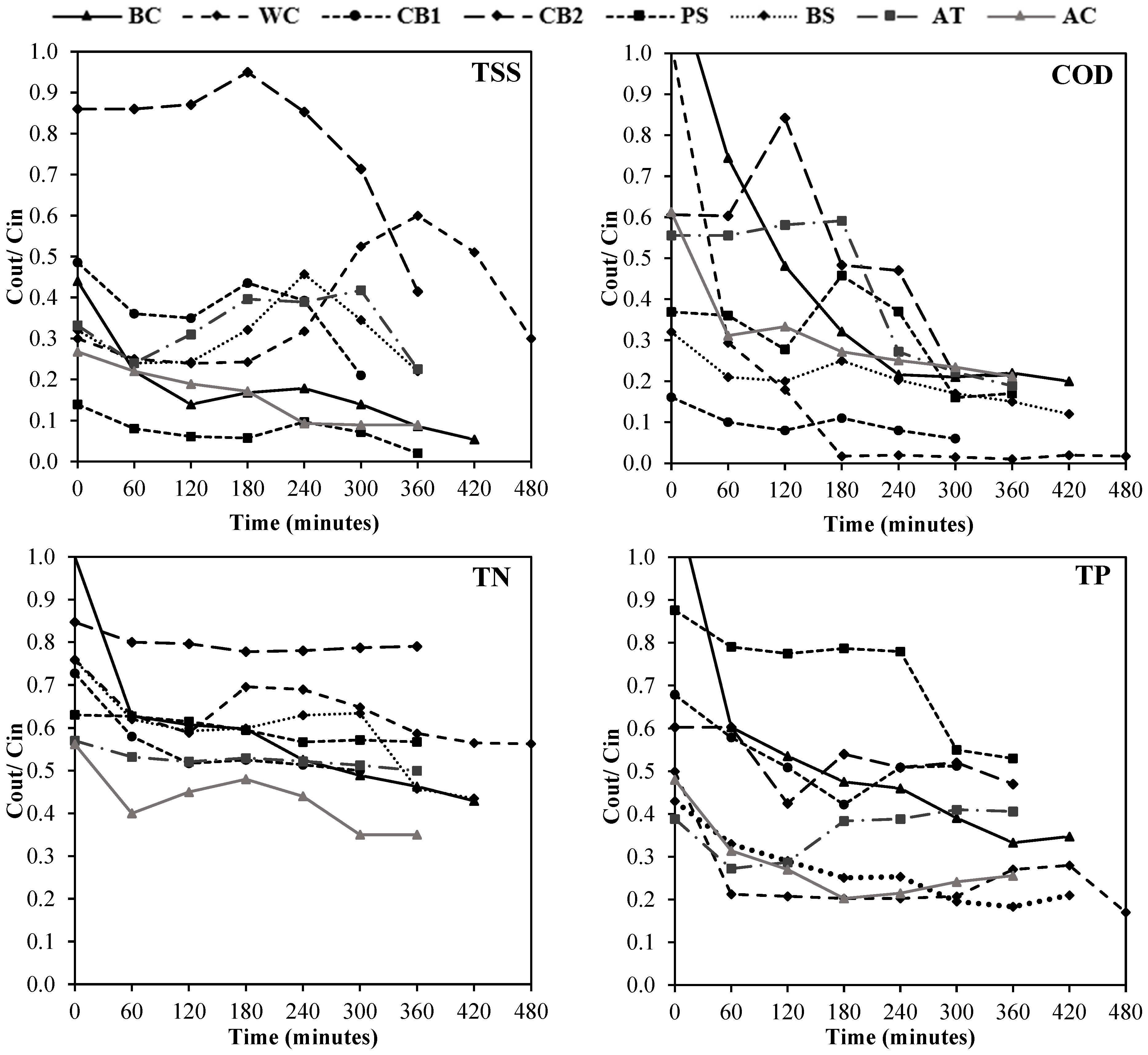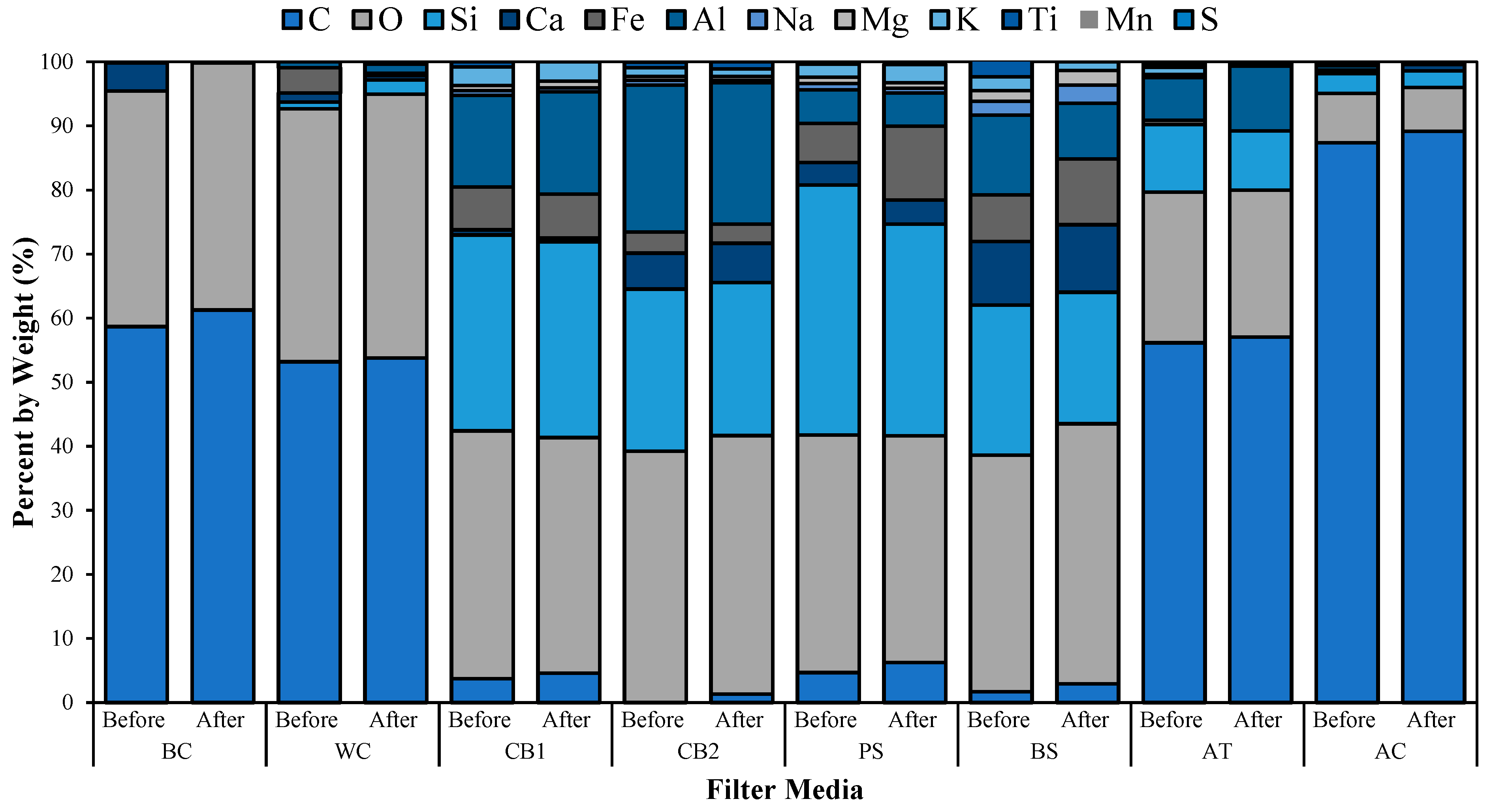Performance Evaluation of Various Filter Media for Multi-Functional Purposes to Urban Constructed Wetlands
Abstract
:1. Introduction
2. Materials and Methods
2.1. Physical Properties of Filter Media
2.2. Laboratory Column Testing
3. Results and Discussion
3.1. Changes in Water Quality Parameters
3.2. Carbon Storage Potential through SEM-EDX Analysis
3.3. Performance Evaluation of Filter Media
4. Conclusions
Author Contributions
Funding
Institutional Review Board Statement
Informed Consent Statement
Data Availability Statement
Acknowledgments
Conflicts of Interest
References
- Barbera, A.C.; Vymazal, J.; Maucieri, C. Greenhouse Gases Formation and Emission. In Encyclopedia of Ecology, 2nd ed.; Elsevier: Amsterdam, The Netherlands, 2019; Volume 2. [Google Scholar] [CrossRef]
- Yin, J.; Gentine, P.; Zhou, S.; Sullivan, S.C.; Wang, R.; Zhang, Y.; Guo, S. Large Increase in Global Storm Runoff Extremes Driven by Climate and Anthropogenic Changes. Nat. Commun. 2018, 9, 4389. [Google Scholar] [CrossRef] [PubMed]
- UNEP. Greenhouse Gases Are Depriving Our Oceans of Oxygen. 10 April 2019. Available online: https://www.unep.org/news-and-stories/story/greenhouse-gases-are-depriving-our-oceans-oxygen (accessed on 30 October 2023).
- Kumar, A.; Bhattacharya, T.; Mukherjee, S.; Sarkar, B. A Perspective on Biochar for Repairing Damages in the Soil–Plant System Caused by Climate Change-Driven Extreme Weather Events. Biochar 2022, 4, 22. [Google Scholar] [CrossRef]
- De Klein, J.J.M.; Van der Werf, A.K. Balancing Carbon Sequestration and GHG Emissions in a Constructed Wetland. Ecol. Eng. 2014, 66, 36–42. [Google Scholar] [CrossRef]
- Hsu, C.B.; Hsieh, H.L.; Yang, L.; Wu, S.H.; Chang, J.S.; Hsiao, S.C.; Su, H.C.; Yeh, C.H.; Ho, Y.S.; Lin, H.J. Biodiversity of Constructed Wetlands for Wastewater Treatment. Ecol. Eng. 2011, 37, 1533–1545. [Google Scholar] [CrossRef]
- Leng, L.; Xiong, Q.; Yang, L.; Li, H.; Zhou, Y.; Zhang, W.; Jiang, S.; Li, H.; Huang, H. An Overview on Engineering the Surface Area and Porosity of Biochar. Sci. Total Environ. 2021, 763, 144204. [Google Scholar] [CrossRef] [PubMed]
- Niu, S.; Wang, X.; Yu, J.; Kim, Y. Pollution Reduction by Recirculated Fill-and-Drain Mesocosm Wetlands Packed with Woodchip/Pumice Treating Impervious Road Stormwater. Environ. Technol. 2020, 41, 1627–1636. [Google Scholar] [CrossRef] [PubMed]
- Cescon, A.; Jiang, J.Q. Filtration Process and Alternative Filter Media Material in Water Treatment. Water 2020, 12, 3377. [Google Scholar] [CrossRef]
- Hossain, M.S.; Islam, M.A.; Badhon, F.F.; Imtiaz, T. Properties and Behavior of Soil—Online Lab Manual; Mavs Open Press: Arlington, TX, USA, 2021. [Google Scholar]
- ASTM D854-14; Standard Test Methods for Specific Gravity of Soil Solids by Water Pycnometer. ASTM: West Conshohocken, PA, USA, 2014. [CrossRef]
- Guerra, H.B.; Yuan, Q.; Kim, Y. Filter Media Washing Prior to Installation in Stormwater Treatment Facilities. Desalination Water Treat. 2018, 109, 64–71. [Google Scholar] [CrossRef]
- Reddy, K.R.; Xie, T.; Dastgheibi, S. Evaluation of Biochar as a Potential Filter Media for the Removal of Mixed Contaminants from Urban Storm Water Runoff. J. Environ. Eng. 2014, 140, 04014043. [Google Scholar] [CrossRef]
- Segismundo, E.Q.; Kim, L.H.; Jeong, S.M.; Lee, B.S. A Laboratory Study on the Filtration and Clogging of the Sand-Bottom Ash Mixture for Stormwater Infiltration Filter Media. Water 2017, 9, 32. [Google Scholar] [CrossRef]
- Mercado, J.M.R.; Maniquiz-Redillas, M.C.; Kim, L.H. Laboratory Study on the Clogging Potential of a Hybrid Best Management Practice. Desalination Water Treat. 2015, 53, 3126–3133. [Google Scholar] [CrossRef]
- American Public Health Association (APHA); American Water Works Association (AWWA); World Economic Forum (WEF). Standard Methods for the Examination of Water and Wastewater, 18th ed.; Greenberg, A., Clesceri, L., Eaton, A., Eds.; AWWA: Denver, CO, USA, 1992. [Google Scholar]
- Gunawardana, C.; Goonetilleke, A.; Egodawatta, P.; Dawes, L.; Kokot, S. Source Characterisation of Road Dust Based on Chemical and Mineralogical Composition. Chemosphere 2012, 87, 163–170. [Google Scholar] [CrossRef] [PubMed]
- Guerra, H.B.; Kim, Y. An Investigation into the Release of Chemical Oxygen Demand in Organic Filter Media. J. Wetl. Res. 2020, 22, 171–177. [Google Scholar]
- Dan, A.; Zhang, X.; Dai, Y.; Chen, C.; Yang, Y. Occurrence and Removal of Quinolone, Tetracycline, and Macrolide Antibiotics from Urban Wastewater in Constructed Wetlands. J. Clean. Prod. 2020, 252, 119677. [Google Scholar] [CrossRef]
- Mariana, M.; Abdul, A.K.; Mistar, E.M.; Yahya, E.B.; Alfatah, T.; Danish, M.; Amayreh, M. Recent Advances in Activated Carbon Modification Techniques for Enhanced Heavy Metal Adsorption. J. Water Process Eng. 2021, 43, 102221. [Google Scholar] [CrossRef]
- Azreen, I.; Lija, Y.; Zahrim, A.Y. Ammonia Nitrogen Removal from Aqueous Solution by Local Agricultural Wastes. IOP Conf. Ser. Mater. Sci. Eng. 2017, 206, 012077. [Google Scholar] [CrossRef]
- Manthiram Karthik, R.; Philip, L. Sorption of Pharmaceutical Compounds and Nutrients by Various Porous Low Cost Adsorbents. J. Environ. Chem. Eng. 2021, 9, 104916. [Google Scholar] [CrossRef]
- Zhu, T.; Jenssen, P.D.; Mæhlum, T.; Krogstad, T. Phosphorus Sorption and Chemical Characteristics of Lightweight Aggregates (LWA)—Potential Filter Media in Treatment Wetlands. Water Sci. Technol. 1997, 35, 103–108. [Google Scholar] [CrossRef]
- Xiong, W.; Wells, R.K.; Giammar, D.E. Carbon Sequestration in Olivine and Basalt Powder Packed Beds. Environ. Sci. Technol. 2017, 51, 2105–2112. [Google Scholar] [CrossRef]
- Zhang, M.; Bradford, S.A.; Simunek, J.; Vereecken, H.; Klumpp, E. Do Goethite Surfaces Really Control the Transport and Retention of Multi-Walled Carbon Nanotubes in Chemically Heterogeneous Porous Media? Environ. Sci. Technol. 2016, 50, 12713–12721. [Google Scholar] [CrossRef]
- Ruggieri, G.; Gherardi, F. Editorial for Special Issue “Geological and Mineralogical Sequestration of CO2”. Minerals 2020, 10, 603. [Google Scholar] [CrossRef]
- Rocha, C. Sandy Sediments as Active Biogeochemical Reactors: Compound Cycling in the Fast Lane. Aquat. Microb. Ecol. 2008, 53, 119–127. [Google Scholar] [CrossRef]
- Nolan, N.E.; Kulmatiski, A.; Beard, K.H.; Norton, J.M. Activated Carbon Decreases Invasive Plant Growth by Mediating Plant—Microbe Interactions. AoB Plants 2015, 7, plu072. [Google Scholar] [CrossRef] [PubMed]
- Gupta, P.; Ann, T.W.; Lee, S.M. Use of Biochar to Enhance Constructed Wetland Performance in Wastewater Reclamation. Environ. Eng. Res. 2016, 21, 36–44. [Google Scholar] [CrossRef]
- Deng, S.; Chen, J.; Chang, J. Application of Biochar as an Innovative Substrate in Constructed Wetlands/Biofilters for Wastewater Treatment: Performance and Ecological Benefits. J. Clean. Prod. 2021, 293, 126156. [Google Scholar] [CrossRef]
- Hallberg, M.; Renman, A.; Berndtsson, L.; Renman, G. Evaluation of a Sand Filter Material for Road Runoff Treatment–Pilot-Scale Field Trial Focused on Copper and Zinc Removal. Water Pract. Technol. 2022, 17, 1652–1665. [Google Scholar] [CrossRef]
- Kandasamy, J.; Beecham, S.; Dunphy, A. Stormwater Sand Filters in Water-Sensitive Urban Design. Proc. Inst. Civ. Eng. Water Manag. 2008, 161, 55–64. [Google Scholar] [CrossRef]
- Jayabalan, J.B.; Amirthalingam, S.; Sekar, S.; Santhanam, N.K.; Manoharan, S. Treatment of Textile Effluent Using Sub Surface Flow Constructed Wetlands. AIP Conf. Proc. 2020, 2240, 130001. [Google Scholar] [CrossRef]
- Sounthararajah, D.P.; Loganathan, P.; Kandasamy, J.; Vigneswaran, S. Removing Heavy Metals Using Permeable Pavement System with a Titanate Nano-Fibrous Adsorbent Column as a Post Treatment. Chemosphere 2017, 168, 467–473. [Google Scholar] [CrossRef]
- Akbar, N.A.; Aziz, H.A.; Adlan, M.N. The Characteristics of Limestone and Anthracite Coal as Filter Media in Treating Pollutants from Groundwater. Int. J. Environ. Sci. Dev. 2021, 12, 58–62. [Google Scholar] [CrossRef]
- Bulta, A.L.; Micheal, G.A.W. Evaluation of the Efficiency of Ceramic Filters for Water Treatment in Kambata Tabaro Zone, Southern Ethiopia. Environ. Syst. Res. 2019, 8, 1. [Google Scholar] [CrossRef]
- Andersson, A.; Laurent, P.; Kihn, A.; Prévost, M.; Servais, P. Impact of Temperature on Nitrification in Biological Activated Carbon (BAC) Filters Used for Drinking Water Treatment. Water Res. 2001, 35, 2923–2934. [Google Scholar] [CrossRef] [PubMed]




| Filter Media | BC | WC | CB1 | CB2 | PS | BS | AT | AC |
|---|---|---|---|---|---|---|---|---|
| Image |  |  |  |  |  |  |  |  |
| Particle Size (mm) | 3–5 | 30–50 | 20–60 | 10–20 | 2–5 | 5–10 | 2–5 | 1–2 |
| Porosity (%) | 44 | 60 | 62 | 53 | 40 | 56 | 44 | 52 |
| Void Ratio | 0.3056 | 0.2958 | 0.3827 | 0.3464 | 0.2857 | 0.359 | 0.3056 | 0.3421 |
| Bulk Density (g/cm3) | 0.2724 | 0.2202 | 0.8222 | 0.9721 | 1.0318 | 1.0264 | 1.0045 | 0.7844 |
| Specific Gravity | 0.2724 | 0.2202 | 0.8222 | 0.9721 | 1.0318 | 1.0264 | 1.0045 | 0.7844 |
| Permeability (m/s) | 0.0279 | 0.4127 | 0.128 | 0.0686 | 0.0397 | 0.0675 | 0.0298 | 0.0120 |
| Water Quality Parameters | Unit | Inflow | Outflow | |||||||
|---|---|---|---|---|---|---|---|---|---|---|
| BC | WC | CB1 | CB2 | PS | BS | AT | AC | |||
| pH | - | 7.65 ± 0.19 | 7.33 ± 0.05 | 7.38 ± 0.06 | 7.53 ± 0.09 | 8.41 ± 0.11 | 7.37 ± 0.04 | 7.48 ± 0.08 | 7.25 ± 0.87 | 8.67 ± 0.35 |
| Conductivity | μs/cm | 388 ± 604.4 | 162.91 ± 63.67 | 221.79 ± 218.65 | 140.38 ± 7.14 | 140.33 ± 2.97 | 121.99 ± 4.62 | 173.01 ± 124.13 | 129.88 ± 11.97 | 127.37 ± 17.38 |
| TSS | mg/L | 93 ± 15.65 | 14.39 ± 9.16 | 29.07 ± 18.88 | 36.73 ± 12.35 | 60.75 ± 33.43 | 5.92 ± 3.78 | 20.69 ± 17.24 | 20.92 ± 21.20 | 11.42 ± 7.87 |
| COD | mg/L | 7.06 ± 5.57 | 11.42 ± 8.93 | 3.29 ± 3.26 | 0.89 ± 0.70 | 4.32 ± 1.09 | 3.12 ± 1.97 | 2.01 ± 1.50 | 3.28 ± 3.66 | 3.27 ± 1.50 |
| NO2 | mg/L | 0.007 ± 0.011 | 0.005 ± 0.003 | 0.006 ± 0.002 | 0.007 ± 0.003 | 0.002 ± 0.001 | 0.002 ± 0.001 | 0.049 ± 0.002 | 0.003 ± 0.002 | 0.003 ± 0.001 |
| NO3 | mg/L | 1.90 ± 0.60 | 1.11 ± 0.64 | 1.63 ± 0.43 | 2.03 ± 0.52 | 1.94 ± 0.59 | 1.73 ± 0.33 | 1.62 ± 0.37 | 2.05 ± 0.41 | 0.61 ± 0.46 |
| NH4-N | mg/L | 0.05 ± 0.019 | 0.044 ± 0.011 | 0.021 ± 0.010 | 0.029 ± 0.017 | 0.058 ± 0.033 | 0.035 ± 0.018 | 0.022 ± 0.011 | 0.029 ± 0.013 | 0.025 ± 0.013 |
| TN | mg/L | 3.98 ± 1.33 | 3.30 ± 1.01 | 3.21 ± 0.73 | 2.91 ± 0.91 | 4.02 ± 0.14 | 2.97 ± 0.27 | 3.29 ± 0.39 | 2.66 ± 0.13 | 1.75 ± 0.90 |
| PO4-P | mg/L | 0.04 ± 0.024 | 0.180 ± 0.283 | 0.028 ± 0.026 | 0.029 ± 0.012 | 0.044 ± 0.029 | 0.067 ± 0.005 | 0.026 ± 0.026 | 0.026 ± 0.028 | 0.037 ± 0.046 |
| TP | mg/L | 0.076 ± 0.062 | 0.204 ± 0.285 | 0.039 ± 0.029 | 0.068 ± 0.029 | 0.069 ± 0.038 | 0.090 ± 0.029 | 0.034 ± 0.035 | 0.047 ± 0.034 | 0.042 ± 0.054 |
| Factors | Filter Media | |||||||
|---|---|---|---|---|---|---|---|---|
| BC | WC | CB1 | CB2 | PS | BS | AT | AC | |
| Pollutant Reduction | ||||||||
| Suspended Solids | H | M | M | L | H | H | H | H |
| COD | L | M | H | M | M | H | M | M |
| TN | L | L | M | L | M | L | M | M |
| TP | L | M | L | L | L | M | M | M |
| Carbon storage potential (from SEM-EDX Analysis) | M | L | M | M | H | M | M | H |
| Cost-effectiveness | M | H | M | M | M | L | H | L |
| Frequently Applied | M | M | L | L | H | L | M | M |
| Overall Rating | M (1.7) | M (1.9) | M (1.9) | L (1.4) | H (2.3) | M (1.9) | H (2.3) | M (2.1) |
| Country | Application | Technology | Filter Media | Performance | Reference |
|---|---|---|---|---|---|
| South Korea | Synthetic wastewater | Constructed wetlands | Biochar | Average removal efficiency of 91%, 58%, and 80% for COD, TN, and TP, respectively. | [29] |
| China | Wastewater treatment | Constructed wetlands | Biochar | Improved removal of nitrogen (>20% on average), phosphorus, organic contaminants, heavy metals, and pathogens from wastewater. Enhanced macrophyte growth and mitigated greenhouse gas emissions. | [30] |
| South Korea | Stormwater treatment | Constructed wetlands | Woodchip | TSS Removal efficiency amounting to 89–100%. Improved nitrogen removal through leaching organic matter as carbon sources. | [8] |
| Sweden | Stormwater treatment | Constructed wetlands | Sand | Reported total Cu and Zn removal of 67% and 93%, respectively. | [31] |
| Australia | Stormwater treatment | Stormwater sand filters | Coarse and fine sand | Removal reduction for Zn of 80%. High nutrient removal and superior suspended solids removal. Reduction in fecal coliforms in the stormwater was 65% (fine filter media) and 79% (coarse media). | [32] |
| Ethiopia | Water treatment | Water treatment | Ceramic filter media | Effective in maintaining hydraulic flow and reducing clogging. Showed an average removal efficiency of 60% to 89% for turbidity, total coliform, E. coli, Ca, Mg, S, P, Fe, and N. | [36] |
| Australia | Stormwater treatment | Permeable pavement system | Basalt | Achieved 38% to 67% removal of heavy metals from synthetic stormwater. | [34] |
| Malaysia | Groundwater pollutants | Groundwater remediation | Anthracite | Capability of adsorbing organic pollutants due to their hydrophobic characteristics. Alternative to remove pollutants in groundwater. | [35] |
| Canada | Drinking water treatment | Drinking water treatment | Activated Carbon | Exhibited removal rate of over 90% for ammonia. High adsorption capabilities for volatile organic compounds. | [37] |
| India | Textile effluent treatment | Constructed wetlands | Activated Carbon | BOD and COD removal efficiencies were greater than 40%. Effective in adsorbing and reducing organic matter and pollutants. | [33] |
| South Korea | Synthetic stormwater runoff | Application to UCWs | Biochar | TSS and TN removal efficiency of 79% and 17%, respectively. | This study |
| Woodchip | TSS, COD, TN, and TP removal efficiency of 58%, 53%, 19%, and 49%, respectively. | ||||
| Ceramic balls 1 | TSS, COD, TN, and TP removal efficiency of 47%, 87%, 27%, and 10%, respectively. | ||||
| Ceramic balls 2 | TSS, COD, and TP removal efficiency of 13%, 39%, and 8%, respectively. | ||||
| Porous sand | TSS, COD, and TN removal efficiency of 92%, 56%, and 26%, respectively. | ||||
| Basalt | TSS, COD, TN, and TP removal efficiency of 70%, 72%, 17%, and 55%, respectively. | ||||
| Anthracite | TSS, COD, TN, and TP removal efficiency of 70%, 54%, 33%, and 38%, respectively. | ||||
| Activated carbon | TSS, COD, TN, and TP removal efficiency of 84%, 54%, 56%, and 44%, respectively. |
Disclaimer/Publisher’s Note: The statements, opinions and data contained in all publications are solely those of the individual author(s) and contributor(s) and not of MDPI and/or the editor(s). MDPI and/or the editor(s) disclaim responsibility for any injury to people or property resulting from any ideas, methods, instructions or products referred to in the content. |
© 2023 by the authors. Licensee MDPI, Basel, Switzerland. This article is an open access article distributed under the terms and conditions of the Creative Commons Attribution (CC BY) license (https://creativecommons.org/licenses/by/4.0/).
Share and Cite
Vispo, C.; Geronimo, F.K.; Jeon, M.; Kim, L.-H. Performance Evaluation of Various Filter Media for Multi-Functional Purposes to Urban Constructed Wetlands. Sustainability 2024, 16, 287. https://doi.org/10.3390/su16010287
Vispo C, Geronimo FK, Jeon M, Kim L-H. Performance Evaluation of Various Filter Media for Multi-Functional Purposes to Urban Constructed Wetlands. Sustainability. 2024; 16(1):287. https://doi.org/10.3390/su16010287
Chicago/Turabian StyleVispo, Chiny, Franz Kevin Geronimo, Minsu Jeon, and Lee-Hyung Kim. 2024. "Performance Evaluation of Various Filter Media for Multi-Functional Purposes to Urban Constructed Wetlands" Sustainability 16, no. 1: 287. https://doi.org/10.3390/su16010287
APA StyleVispo, C., Geronimo, F. K., Jeon, M., & Kim, L.-H. (2024). Performance Evaluation of Various Filter Media for Multi-Functional Purposes to Urban Constructed Wetlands. Sustainability, 16(1), 287. https://doi.org/10.3390/su16010287







